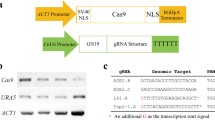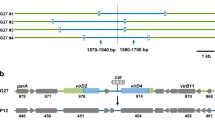Abstract
The efficiency of gene targeting by integration through homologous recombination (homologous integration, HI) in the human pathogen Cryptococcus neoformans remains unsatisfactory. In order to achieve a much more efficient gene targeting system in C. neoformans, a new double knockout strain in genes involved in the non-homologous end joining (NHEJ) pathway was constructed. HI frequency was elevated by as much as approximately fivefold in the single or double knockout strains in NHEJ genes, and the frequency depended on the gene targeted. None of the NHEJ gene knockouts showed significant differences in regular growth, sensitivity to DNA-damaging drugs or UV, and virulence compared to the wild-type control, suggesting that the NHEJ pathway does not play a significant role in these biological stresses in C. neoformans. It was also suggested that the genes analyzed in this study are components of a single NHEJ pathway, as the mutants (including the double mutant) displayed the same phenotypes.






Similar content being viewed by others
References
Aylon Y, Kupiec M (2004) DSB repair: the yeast paradigm. DNA Repair 3:797–815
Casadevall A, Perfect JR (1998) Cryptococcus neoformans. ASM Press, Washington
Chang PK (2008) A highly efficient gene-targeting system for Aspergillus parasiticus. Lett Appl Microbiol 46:587–592
Chaskes S, Tyndall RL (1975) Pigment production by Cryptococcus neoformans from para- and ortho-diphenols: effect of the nitrogen source. J Clin Microbiol 1:509–514
Choquer M, Robin G, Le Pêcheur P, Giraud C, Levis C, Viaud M (2008) Ku70 or Ku80 deficiencies in the fungus Botrytis cinerea facilitate targeting of genes that are hard to knock out in a wild-type context. FEMS Microbiol Lett 289:225–232
da Silva Ferreira ME, Kress MR, Savoldi M, Goldman MH, Hartl A, Heinekamp T, Brakhaqe AA, Goldman GH (2006) The akuB KU80 mutant deficient for nonhomologous end joining is a powerful tool for analyzing pathogenicity in Aspergillus fumigatus. Eukaryot Cell 5:207–211
Drivinya A, Shimizu K, Takeo K (2004) Construction of a complete URA5 deletion strain of a human pathogenic yeast Cryptococcus neoformans. Jpn J Med Mycol 45:1–6
Goins CL, Gerik KJ, Lodge JK (2006) Improvements to gene deletion in the fungal pathogen Cryptococcus neoformans: absence of Ku proteins increases homologous recombination, and co-transformation of independent DNA molecules allows rapid complementation of deletion phenotypes. Fungal Genet Biol 43:531–544
Guangtao Z, Hartl L, Schuster A, Polak S, Schmoll M, Wang T, Seidl V, Seiboth B (2009) Gene targeting in a nonhomologous end joining deficient Hypocrea jecorina. J Biotechnol 139:146–151
Ishibashi K, Suzuki K, Ando Y, Takakura C, Inoue H (2006) Nonhomologous chromosomal integration of foreign DNA is completely dependent on MUS-53 (human Lig4 homolog) in Neurospora. Proc Natl Acad Sci USA 103:14871–14876
James TY, Kauff F, Schoch CL, Matheny PB, Hofstetter V, Cox CJ, Celio G, Gueidan C, Fraker E, Miadlikowska J, Lumbsch HT, Rauhut A, Reeb V, Arnold AE, Amtoft A, Stajich JE, Hosaka K, Sung GH, Johnson D, O’Rourke B, Crockett M, Binder M, Curtis JM, Slot JC, Wang Z, Wilson AW, Schüssler A, Longcore JE, O’Donnell K, Mozley-Standridge S, Porter D, Letcher PM, Powell MJ, Taylor JW, White MM, Griffith GW, Davies DR, Humber RA, Morton JB, Sugiyama J, Rossman AY, Rogers JD, Pfister DH, Hewitt D, Hansen K, Hambleton S, Shoemaker RA, Kohlmeyer J, Volkmann-Kohlmeyer B, Spotts RA, Serdani M, Crous PW, Hughes KW, Matsuura K, Langer E, Langer G, Untereiner WA, Lücking R, Büdel B, Geiser DM, Aptroot A, Diederich P, Schmitt I, Schultz M, Yahr R, Hibbett DS, Lutzoni F, McLaughlin DJ, Spatafora JW, Vilgalys R (2006) Reconstructing the early evolution of Fungi using a six-gene phylogeny. Nature 443:818–822
Kito H, Fujikawa T, Moriwaki A, Tomono A, Izawa M, Kamakura T, Ohashi M, Sato H, Abe K, Nishimura M (2008) MgLig4, a homolog of Neurospora crassa Mus-53 (DNA ligase IV), is involved in, but not essential for, non-homologous end-joining events in Magnaporthe grisea. Fungal Genet Biol 45:1543–1551
Kooistra R, Hooykaas PJ, Steensma HY (2004) Efficient gene targeting in Kluyveromyces lactis. Yeast 21:781–792
Krappmann S, Sasse C, Braus GH (2006) Gene targeting in Aspergillus fumigatus by homologous recombination is facilitated in a nonhomologous end-joining-deficient genetic background. Eukaryot Cell 5:212–215
Kwon-Chung KJ, Edman JC, Wickes BL (1992) Genetic association of mating types and virulence in Cryptococcus neoformans. Infect Immun 60:602–605
Meyer V, Arentshorst M, EI-Ghezal A, Drews A-C, Kooistra R, van den Hondel CAMJJ, Ram AFJ (2007) Highly efficient gene targeting in the Aspergillus niger kusA mutant. J Biotechnol 128:770–775
Mizutani O, Kudo Y, Saito A, Matsuura T, Inoue H, Abe K, Gomi K (2008) A defect of LigD (human Lig4 homolog) for nonhomologous end joining significantly improves efficiency of gene-targeting in Aspergillus oryzae. Fungal Genet Biol 45:878–889
Nayak T, Szewczyk E, Oakley CE, Osmani A, Ukil L, Murray SL, Hynes MJ, Osmani SA, Oakley BR (2006) A versatile and efficient gene-targeting system for Aspergillus nidulans. Genetics 172:1557–1566
Ninomiya Y, Suzuki K, Ishii C, Inoue H (2004) Highly efficient gene replacements in Neurospora strains deficient for nonhomologous end-joining. Proc Natl Acad Sci USA 101:12248–12253
Pöggeler S, Kück U (2006) Highly efficient generation of signal transduction knockout mutants using a fungal strain deficient in the mammalian ku70 ortholog. Gene 378:1–10
Schorsch C, Köhler T, Boles E (2009) Knockout of the DNA ligase IV homolog gene in the sphingoid base producing yeast Pichia ciferrii significantly increases gene targeting efficiency. Curr Genet 55:381–389
Shimizu K, Li H-M, Virtudazo EV, Watanabe A, Kamei K, Yamaguchi M, Kawamoto S (2010) Deletion of CnLIG4 DNA ligase gene in the fungal pathogen Cryptococcus neoformans elevates homologous recombination efficiency. Mycoscience 51:28–33
Takahashi T, Masuda T, Koyama Y (2006) Enhanced gene targeting frequency in ku70 and ku80 disruption mutants of Aspergillus sojae and Aspergillus oryzae. Mol Genet Genomics 275:460–470
Ueno K, Uno J, Nakayama H, Sasamoto K, Mikami Y, Chibana H (2007) Development of highly efficient gene targeting system induced by transient repression of YKU80 expression in Candida glabrata. Eukaryot Cell 6:1239–1247
Villalba F, Collemare J, Landraud P, Lambou K, Brozek V, Cirer B, Morin D, Bruel C, Beffa R, Lebrun M-H (2008) Improved gene targeting in Magnaporthe grisea by inactivation of MgKU80 required for non-homologous end joining. Fungal Genet Biol 45:68–75
Yamada T, Makimura K, Hisajima T, Ishihara Y, Umeda Y, Abe S (2009) Enhanced gene replacements in Ku80 disruption mutants of the dermatophyte, Trichophyton mentagrophytes. FEMS Microbiol Lett 298:208–217
Acknowledgments
This study was partly supported by a Grant-in-Aid from the Ministry of Education, Culture, Sports, Science and Technology of Japan (18790302) to KS.
Author information
Authors and Affiliations
Corresponding author
About this article
Cite this article
Li, HM., Virtudazo, E.V., Toh-e, A. et al. Non-homologous end joining pathway of the human pathogen Cryptococcus neoformans influences homologous integration efficiency but not virulence. Mycoscience 51, 272–280 (2010). https://doi.org/10.1007/s10267-010-0038-7
Received:
Accepted:
Published:
Issue Date:
DOI: https://doi.org/10.1007/s10267-010-0038-7




